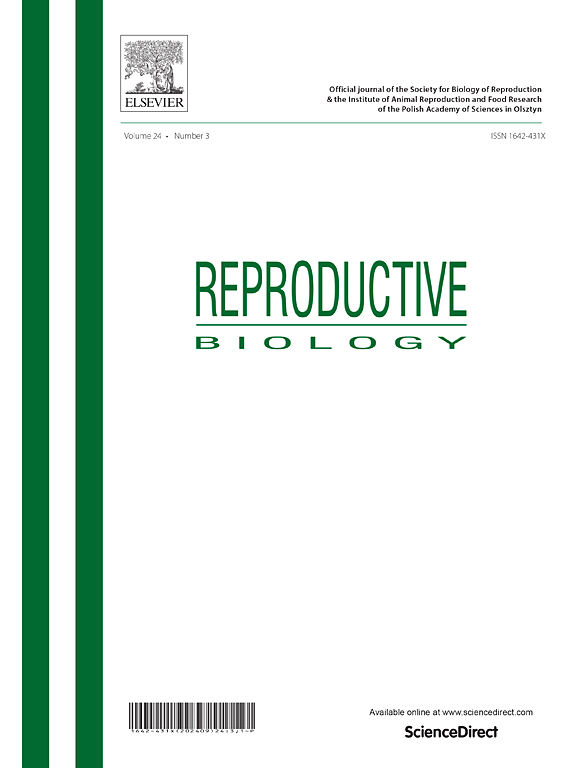Inducible differentiation of buffalo (Bubalus bubalis) embryonic stem cells towards male and female germ cell-like lineages under ex vivo BMP4-mediated stimulation
IF 2.5
3区 生物学
Q3 REPRODUCTIVE BIOLOGY
引用次数: 0
Abstract
Bone Morphogenetic Proteins have been reported to play important roles in developmental biology across the species. The present study investigates the role of BMP4 in inducing germ lineage development. For this purpose, buffalo ES cells were subjected to in vitro differentiation under suspension as well as adherent cultures, at different BMP4 doses and time periods. ES cell colonies were differentiated as EBs as well as adherent monolayers under different BMP4 concentrations (20, 50 and 100 ngml−1) for different time intervals (4, 8 and 14 days). The differentiated cultures were subjected to transcriptional profiling for germ lineage associated genes. qPCR data analysis revealed that BMP4 at a concentration of 50–100 ngml−1 and for a period of 14 days led to maximum induction of such germ lineage associated genes like DAZL, VASA, PLZF (PGC-specific); SYCP3, MLH1, TNP1/2 and PRM2 (Meiotic genes); BOULE and TEKT1 (Spermatocyte markers); and GDF9, ZP2 and 3 (Oocyte markers). Immunocytochemical analysis of the differentiated cultures revealed positive expression of PGC-markers (c-KIT, DAZL and VASA), Meiotic-markers (SYCP3, MLH1 and PROTAMINE1), Spermatocyte-markers (ACROSIN and HAPRIN) and Oocyte-markers (GDF9 and ZP4), marking thereby the differentiation towards germ lineage cells. Oocyte-like structures (OLS) obtained in monolayer differentiated cultures harbored a big nucleus covered with a ZP4 coat, so typical of an oocyte. These OLS, in extended cultures, showed embryonic development and progressed through different embryonic-like structures. Global DNA methylation analysis of the optimally differentiated cultures showed significantly (p < 0.05) decreased levels of 5-methyl-2-deoxycytidine, a mimic of the methylation erasure process typical of gametogenesis. Expression of PGC markers, methylation erasure, and meiotic markers together with expression of spermatocyte and oocyte markers is suggestive of post-meiotic progression into spermatogenesis and oogenesis, respectively- thus reflecting onset of in vitro gametogenesis.
在体外bmp4介导的刺激下,水牛胚胎干细胞诱导分化为雄性和雌性生殖细胞样谱系
据报道,骨形态发生蛋白在整个物种的发育生物学中起着重要作用。本研究探讨了BMP4在诱导生殖系发育中的作用。为此,在不同BMP4剂量和时间下,水牛胚胎干细胞在悬浮和贴壁培养下进行体外分化。在不同的BMP4浓度(20、50和100 ngml−1)下,不同的时间间隔(4、8和14天),ES细胞菌落分化为EBs和贴壁单层。分化后的培养物进行了生殖谱系相关基因的转录谱分析。qPCR数据分析显示,BMP4浓度为50-100 ngml−1,作用时间为14天,可最大限度地诱导DAZL、VASA、PLZF (pgc特异性)等生殖谱系相关基因;SYCP3、MLH1、TNP1/2和PRM2(减数分裂基因);BOULE和TEKT1(精母细胞标志物);GDF9、ZP2和3(卵母细胞标记物)。免疫细胞化学分析显示pgc标记物(c-KIT、DAZL和VASA)、减数分裂标记物(SYCP3、MLH1和PROTAMINE1)、精母细胞标记物(ACROSIN和HAPRIN)和卵母细胞标记物(GDF9和ZP4)的阳性表达,表明分化为生殖系细胞。在单层分化培养中获得的卵母细胞样结构(OLS)含有一个覆盖着ZP4外壳的大细胞核,这是卵母细胞的典型特征。这些OLS在扩展培养中表现出胚胎发育,并通过不同的胚胎样结构发展。优化分化培养的整体DNA甲基化分析显示,5-甲基-2-脱氧胞苷水平显著降低(p <; 0.05),这是配子体发生典型的甲基化消除过程的模拟物。PGC标记、甲基化消除和减数分裂标记的表达与精母细胞和卵母细胞标记的表达分别提示减数分裂后进入精子发生和卵发生,从而反映了体外配子体发生的开始。
本文章由计算机程序翻译,如有差异,请以英文原文为准。
求助全文
约1分钟内获得全文
求助全文
来源期刊

Reproductive biology
生物-生殖生物学
CiteScore
3.90
自引率
0.00%
发文量
95
审稿时长
29 days
期刊介绍:
An official journal of the Society for Biology of Reproduction and the Institute of Animal Reproduction and Food Research of Polish Academy of Sciences in Olsztyn, Poland.
Reproductive Biology is an international, peer-reviewed journal covering all aspects of reproduction in vertebrates. The journal invites original research papers, short communications, review articles and commentaries dealing with reproductive physiology, endocrinology, immunology, molecular and cellular biology, receptor studies, animal breeding as well as andrology, embryology, infertility, assisted reproduction and contraception. Papers from both basic and clinical research will be considered.
 求助内容:
求助内容: 应助结果提醒方式:
应助结果提醒方式:


